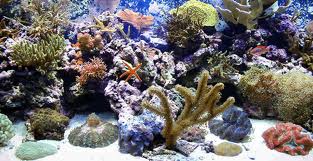Anyone looking to start their own salt water aquarium would do well to plan ahead before actually diving into the hobby. Knowing what type of equipment you need, and how it works to support a beautiful array of saltwater fish and coral growth, is essential to building a successful and sustainable aquarium.

Basic Saltwater Equipment
* Aquarium: A smaller tank (<30 gallons) could be ideal for a beginner not wanting to sink too much money into the project, but a larger tank will suffer less from small changes in salinity and pH levels because those fluctuations happen in a the larger body of water. You also need to consider whether your floor can support the weight of the tank, stand and water.
* Lighting: Any fluorescent-light head will do for a fish-only tank, illuminating the fish. Living coral organisms and live plants require adequate light to support growth, however, which means running a wide-spectrum lamp for up to 12 hours a day. Metal-halide lamps produce more intense light, but they also put out a lot of heat, which can affect your water temperature.
* Bio-filter: Filter systems are designed to assist the naturally-occurring bacteria in your tank in the nitrification process that manages accumulating toxins in the water. You’ll also deal with these toxins by performing regular water changes.
* Protein Skimmer: A protein skimmer helps improve water-quality by removing organic compounds before they can break down and introduce ammonia. Less ammonia means a reduced load on your filter and lower toxicity overall.
* Power Heads: These devices move water through your tank to create an effective water circulation. Better circulation oxygenates the tank, distributes food to stationary organisms and keeps detritus from settling.
* Rock: You can install a substrate layer on the bottom of your aquarium if you want. Live rock is necessary if you’re growing live coral. Be sure you’re using the appropriate rock to grow the type of coral you want.
* Sea Salt Mix: This will help you create the proper levels of salt and other chemicals in your tank.
* Water Test Kits: You’ll need to periodically test salinity and other chemical concentrations to maintain the health of the tank. You should also check levels during water changes.
* Heater and Thermometer: Lights, pumps, power heads and ambient room-temperature can all introduce heat into your aquarium. If that’s not enough to keep temperatures high enough for your tank, you’ll probably need a heater with an automatic thermostat to maintain it.
